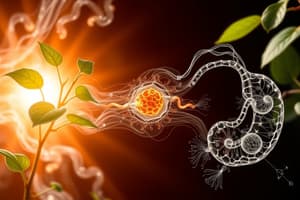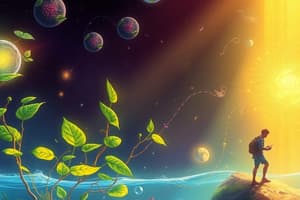Podcast
Questions and Answers
What is the source of oxygen produced during photosynthesis?
What is the source of oxygen produced during photosynthesis?
- C6H12O6
- CO2
- H2O (correct)
- Chlorophyll
What is the primary function of stomata in the leaf?
What is the primary function of stomata in the leaf?
- To allow CO2 to enter and O2 to exit (correct)
- To convert solar energy into chemical energy
- To produce chlorophyll
- To absorb water from the roots
In which part of the leaf are chloroplasts concentrated?
In which part of the leaf are chloroplasts concentrated?
- Thylakoid space
- Mesophyll cells (correct)
- Stomata
- Leaf veins
What is the role of chlorophyll in photosynthesis?
What is the role of chlorophyll in photosynthesis?
What is the purpose of the inner and outer membranes of the chloroplast?
What is the purpose of the inner and outer membranes of the chloroplast?
What is the primary role of autotrophs in the biosphere?
What is the primary role of autotrophs in the biosphere?
What is the product of the reaction 6 CO2 + 12 H2O →?
What is the product of the reaction 6 CO2 + 12 H2O →?
What is the by-product of photosynthesis that is essential for other metabolic processes?
What is the by-product of photosynthesis that is essential for other metabolic processes?
Which of the following organisms is most likely to be a heterotroph?
Which of the following organisms is most likely to be a heterotroph?
What is the primary source of energy for photosynthesis?
What is the primary source of energy for photosynthesis?
What was the question scientists were trying to answer when they traced the process of photosynthesis using isotopes?
What was the question scientists were trying to answer when they traced the process of photosynthesis using isotopes?
What is the opposite of an anabolic process?
What is the opposite of an anabolic process?
What is the primary function of the thylakoid membranes in chloroplasts?
What is the primary function of the thylakoid membranes in chloroplasts?
What is the by-product of the light-dependent reaction in photosynthesis?
What is the by-product of the light-dependent reaction in photosynthesis?
Where do the light-independent reactions of photosynthesis occur?
Where do the light-independent reactions of photosynthesis occur?
What is the energy currency generated during the light-dependent reaction?
What is the energy currency generated during the light-dependent reaction?
What is the role of chlorophyll molecules in photosynthesis?
What is the role of chlorophyll molecules in photosynthesis?
What is the primary function of the Calvin Cycle in photosynthesis?
What is the primary function of the Calvin Cycle in photosynthesis?
What is the primary function of carbon fixation in the process of converting solar energy into chemical energy?
What is the primary function of carbon fixation in the process of converting solar energy into chemical energy?
What is the nature of electromagnetic energy in sunlight?
What is the nature of electromagnetic energy in sunlight?
What is the effect of a shorter wavelength of light on the energy of a photon?
What is the effect of a shorter wavelength of light on the energy of a photon?
What is the primary function of pigments in the process of photosynthesis?
What is the primary function of pigments in the process of photosynthesis?
What is the characteristic of light that is transmitted by chlorophyll?
What is the characteristic of light that is transmitted by chlorophyll?
What is the location of plant pigments in the chloroplast?
What is the location of plant pigments in the chloroplast?
What is the primary function of chlorophyll a in the light reactions?
What is the primary function of chlorophyll a in the light reactions?
What is the outcome of the light-driven electron flow in the light reactions?
What is the outcome of the light-driven electron flow in the light reactions?
What is the role of carotenoids in the light reactions?
What is the role of carotenoids in the light reactions?
Where are ATP and NADPH produced in the chloroplast?
Where are ATP and NADPH produced in the chloroplast?
What is the result of the increase in potential energy of electrons in the light reactions?
What is the result of the increase in potential energy of electrons in the light reactions?
What is the relationship between the light reactions and the Calvin cycle in photosynthesis?
What is the relationship between the light reactions and the Calvin cycle in photosynthesis?
Flashcards are hidden until you start studying




